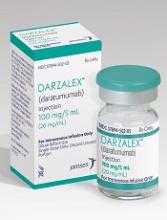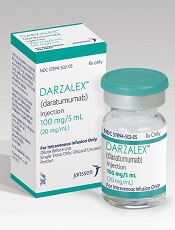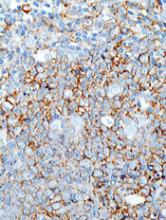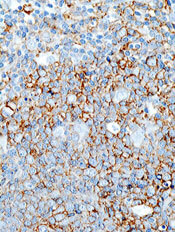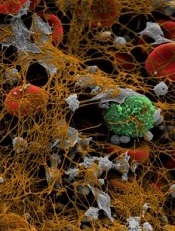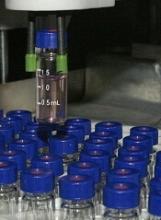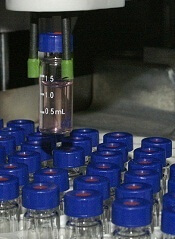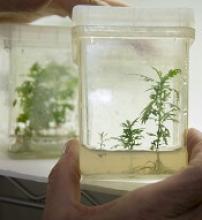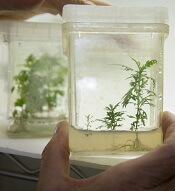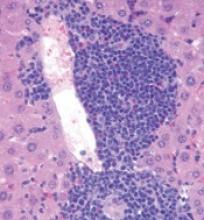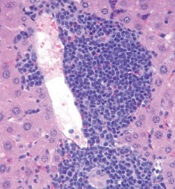User login
EC expands approval for daratumumab in MM
The European Commission (EC) has expanded the approved use of the anti-CD38 antibody daratumumab (Darzalex®).
Daratumumab is now approved for use in combination with lenalidomide and dexamethasone or bortezomib and dexamethasone for the treatment of adults with multiple myeloma (MM) who have received at least 1 prior therapy.
The EC previously granted conditional approval for daratumumab as monotherapy for the treatment of adults with relapsed or refractory MM whose prior treatment included a proteasome inhibitor and an immunomodulatory agent and who demonstrated disease progression on their last therapy.
Now, the EC has granted daratumumab full approval for this indication. The conditional approval was contingent upon Janssen, the company developing daratumumab, providing additional data from the phase 3 POLLUX and CASTOR trials.
As these data have been provided, the EC said the specific obligations associated with the conditional approval have been fulfilled, allowing the switch from conditional to full approval.
The EC’s decision to grant daratumumab approval in combination with lenalidomide and dexamethasone or bortezomib and dexamethasone was also based on data from the POLLUX and CASTOR trials.
In the POLLUX trial, researchers compared treatment with lenalidomide and dexamethasone to treatment with daratumumab, lenalidomide, and dexamethasone in patients with relapsed or refractory MM.
Patients who received daratumumab in combination had a significantly higher response rate and longer progression-free survival than patients who received the 2-drug combination.
However, treatment with daratumumab was associated with infusion-related reactions and a higher incidence of neutropenia.
Results from this trial were published in NEJM in October 2016.
In the CASTOR trial, researchers compared treatment with bortezomib and dexamethasone to treatment with daratumumab, bortezomib, and dexamethasone in patients with previously treated MM.
Patients who received the 3-drug combination had a higher response rate, longer progression-free survival, and a higher incidence of grade 3/4 adverse events than those who received the 2-drug combination.
Results from this trial were published in NEJM in August 2016. ![]()
The European Commission (EC) has expanded the approved use of the anti-CD38 antibody daratumumab (Darzalex®).
Daratumumab is now approved for use in combination with lenalidomide and dexamethasone or bortezomib and dexamethasone for the treatment of adults with multiple myeloma (MM) who have received at least 1 prior therapy.
The EC previously granted conditional approval for daratumumab as monotherapy for the treatment of adults with relapsed or refractory MM whose prior treatment included a proteasome inhibitor and an immunomodulatory agent and who demonstrated disease progression on their last therapy.
Now, the EC has granted daratumumab full approval for this indication. The conditional approval was contingent upon Janssen, the company developing daratumumab, providing additional data from the phase 3 POLLUX and CASTOR trials.
As these data have been provided, the EC said the specific obligations associated with the conditional approval have been fulfilled, allowing the switch from conditional to full approval.
The EC’s decision to grant daratumumab approval in combination with lenalidomide and dexamethasone or bortezomib and dexamethasone was also based on data from the POLLUX and CASTOR trials.
In the POLLUX trial, researchers compared treatment with lenalidomide and dexamethasone to treatment with daratumumab, lenalidomide, and dexamethasone in patients with relapsed or refractory MM.
Patients who received daratumumab in combination had a significantly higher response rate and longer progression-free survival than patients who received the 2-drug combination.
However, treatment with daratumumab was associated with infusion-related reactions and a higher incidence of neutropenia.
Results from this trial were published in NEJM in October 2016.
In the CASTOR trial, researchers compared treatment with bortezomib and dexamethasone to treatment with daratumumab, bortezomib, and dexamethasone in patients with previously treated MM.
Patients who received the 3-drug combination had a higher response rate, longer progression-free survival, and a higher incidence of grade 3/4 adverse events than those who received the 2-drug combination.
Results from this trial were published in NEJM in August 2016. ![]()
The European Commission (EC) has expanded the approved use of the anti-CD38 antibody daratumumab (Darzalex®).
Daratumumab is now approved for use in combination with lenalidomide and dexamethasone or bortezomib and dexamethasone for the treatment of adults with multiple myeloma (MM) who have received at least 1 prior therapy.
The EC previously granted conditional approval for daratumumab as monotherapy for the treatment of adults with relapsed or refractory MM whose prior treatment included a proteasome inhibitor and an immunomodulatory agent and who demonstrated disease progression on their last therapy.
Now, the EC has granted daratumumab full approval for this indication. The conditional approval was contingent upon Janssen, the company developing daratumumab, providing additional data from the phase 3 POLLUX and CASTOR trials.
As these data have been provided, the EC said the specific obligations associated with the conditional approval have been fulfilled, allowing the switch from conditional to full approval.
The EC’s decision to grant daratumumab approval in combination with lenalidomide and dexamethasone or bortezomib and dexamethasone was also based on data from the POLLUX and CASTOR trials.
In the POLLUX trial, researchers compared treatment with lenalidomide and dexamethasone to treatment with daratumumab, lenalidomide, and dexamethasone in patients with relapsed or refractory MM.
Patients who received daratumumab in combination had a significantly higher response rate and longer progression-free survival than patients who received the 2-drug combination.
However, treatment with daratumumab was associated with infusion-related reactions and a higher incidence of neutropenia.
Results from this trial were published in NEJM in October 2016.
In the CASTOR trial, researchers compared treatment with bortezomib and dexamethasone to treatment with daratumumab, bortezomib, and dexamethasone in patients with previously treated MM.
Patients who received the 3-drug combination had a higher response rate, longer progression-free survival, and a higher incidence of grade 3/4 adverse events than those who received the 2-drug combination.
Results from this trial were published in NEJM in August 2016. ![]()
Scientists create online database to aid CML research
A newly launched online database provides researchers with access to data on gene expression in chronic myeloid leukemia (CML).
The LEUKomics database includes datasets relating to clinical parameters in CML, normal and leukemic stem cells, CML disease stages, treatments for the disease, and mouse models of CML.
The database is free for researchers to use and share.
The scientists who developed the database hope it will increase our understanding of CML and lead to new treatments for the disease.
“LEUKomics is a very valuable resource and could help us to reveal new underlying mechanisms that drive CML,” said Jeff Evans, Director of the Institute of Cancer Sciences at the University of Glasgow in Scotland.
“It has the potential to transform CML research on a global level, as the findings can be downloaded and shared with other researchers across the world. We also hope it inspires new research ideas and ultimately fuels a global search into finding cures for CML.”
The LEUKomics database includes datasets with information on gene expression related to:
- Clinical parameters in CML, such as disease aggressiveness and response to treatment
- Stem and progenitor cells from CML patients and healthy individuals
- Chronic, accelerated, and blast phases of CML
- CML treatment (currently only tyrosine kinase inhibitors)
- Stem and progenitor cells from mouse models of CML.
The LEUKomics database was launched by scientists at the University of Glasgow and the University of Melbourne.
The website has been built as part of the stem cell database Stemformatics, with funding from the Scottish Cancer Foundation and Bloodwise.
“Thanks to research, most patients with CML will now live a normal life by taking a single pill,” said Alasdair Rankin, Director of Research at Bloodwise in London, England.
“But treatment is life-long, and not everyone can tolerate the side effects from their treatment or may not respond and see their CML return. There remains a need to develop a permanent cure for all people with this blood cancer. LEUKomics is a highly innovative way to speed up this search for a cure and should be a valuable asset for the global blood cancer research community. We look forward to seeing its impact in the months to come.”
The LEUKomics database can be accessed at: www.stemformatics.org/leukomics. ![]()
A newly launched online database provides researchers with access to data on gene expression in chronic myeloid leukemia (CML).
The LEUKomics database includes datasets relating to clinical parameters in CML, normal and leukemic stem cells, CML disease stages, treatments for the disease, and mouse models of CML.
The database is free for researchers to use and share.
The scientists who developed the database hope it will increase our understanding of CML and lead to new treatments for the disease.
“LEUKomics is a very valuable resource and could help us to reveal new underlying mechanisms that drive CML,” said Jeff Evans, Director of the Institute of Cancer Sciences at the University of Glasgow in Scotland.
“It has the potential to transform CML research on a global level, as the findings can be downloaded and shared with other researchers across the world. We also hope it inspires new research ideas and ultimately fuels a global search into finding cures for CML.”
The LEUKomics database includes datasets with information on gene expression related to:
- Clinical parameters in CML, such as disease aggressiveness and response to treatment
- Stem and progenitor cells from CML patients and healthy individuals
- Chronic, accelerated, and blast phases of CML
- CML treatment (currently only tyrosine kinase inhibitors)
- Stem and progenitor cells from mouse models of CML.
The LEUKomics database was launched by scientists at the University of Glasgow and the University of Melbourne.
The website has been built as part of the stem cell database Stemformatics, with funding from the Scottish Cancer Foundation and Bloodwise.
“Thanks to research, most patients with CML will now live a normal life by taking a single pill,” said Alasdair Rankin, Director of Research at Bloodwise in London, England.
“But treatment is life-long, and not everyone can tolerate the side effects from their treatment or may not respond and see their CML return. There remains a need to develop a permanent cure for all people with this blood cancer. LEUKomics is a highly innovative way to speed up this search for a cure and should be a valuable asset for the global blood cancer research community. We look forward to seeing its impact in the months to come.”
The LEUKomics database can be accessed at: www.stemformatics.org/leukomics. ![]()
A newly launched online database provides researchers with access to data on gene expression in chronic myeloid leukemia (CML).
The LEUKomics database includes datasets relating to clinical parameters in CML, normal and leukemic stem cells, CML disease stages, treatments for the disease, and mouse models of CML.
The database is free for researchers to use and share.
The scientists who developed the database hope it will increase our understanding of CML and lead to new treatments for the disease.
“LEUKomics is a very valuable resource and could help us to reveal new underlying mechanisms that drive CML,” said Jeff Evans, Director of the Institute of Cancer Sciences at the University of Glasgow in Scotland.
“It has the potential to transform CML research on a global level, as the findings can be downloaded and shared with other researchers across the world. We also hope it inspires new research ideas and ultimately fuels a global search into finding cures for CML.”
The LEUKomics database includes datasets with information on gene expression related to:
- Clinical parameters in CML, such as disease aggressiveness and response to treatment
- Stem and progenitor cells from CML patients and healthy individuals
- Chronic, accelerated, and blast phases of CML
- CML treatment (currently only tyrosine kinase inhibitors)
- Stem and progenitor cells from mouse models of CML.
The LEUKomics database was launched by scientists at the University of Glasgow and the University of Melbourne.
The website has been built as part of the stem cell database Stemformatics, with funding from the Scottish Cancer Foundation and Bloodwise.
“Thanks to research, most patients with CML will now live a normal life by taking a single pill,” said Alasdair Rankin, Director of Research at Bloodwise in London, England.
“But treatment is life-long, and not everyone can tolerate the side effects from their treatment or may not respond and see their CML return. There remains a need to develop a permanent cure for all people with this blood cancer. LEUKomics is a highly innovative way to speed up this search for a cure and should be a valuable asset for the global blood cancer research community. We look forward to seeing its impact in the months to come.”
The LEUKomics database can be accessed at: www.stemformatics.org/leukomics. ![]()
England did not benefit from CDF, analysis suggests
The National Health Service’s (NHS) Cancer Drugs Fund (CDF) has not benefitted the people of England and may have been detrimental for English cancer patients, according to researchers.
The group analyzed 29 drugs that were approved for use through the CDF and found the fund did not “deliver meaningful value for patients or society” and may have resulted in patients suffering unnecessarily from adverse effects.
The CDF is money the English government sets aside to pay for cancer drugs that haven’t been approved by the National Institute for Health and Care Excellence (NICE), the health technology assessment body in the UK, and aren’t available within the NHS, the publicly funded national healthcare system for England.
The original CDF was closed in March 2016, but a new CDF was opened at the end of July 2016.
In a study published in Annals of Oncology, researchers looked at 29 drugs that had been approved for use through the CDF for 47 specific indications and were available in January 2015.
The team said only 18 of the indications (38%) were based on clinical trials that reported a statistically significant benefit in terms of patients’ overall survival. The median overall survival benefit was 3.2 months, ranging from 1.4 months to 15.7 months.
The researchers also considered other factors, such as quality of life and adverse effects, to measure the drugs’ value to patients. And the team found that most of the drugs failed to show any evidence of meaningful clinical benefit.
In fact, the researchers said the benefit to patients in real-world situations was probably less than the benefit observed in the clinical trials, since trial participants are carefully selected, have fewer comorbidities, and tend to be younger than patients not included in trials.
“From 2010 when it started to 2016 when it closed, the Cancer Drugs Fund cost the UK taxpayer a total of £1.27 billion, the equivalent of 1 year’s total spending on all cancer drugs in the NHS,” said study author Ajay Aggarwal, of the London School of Hygiene & Tropical Medicine in England.
“The majority of cancer medicines funded through the CDF were found wanting with respect to what patients, clinicians, and NICE would count as clinically meaningful benefit. In addition, no data on the outcome of patients who used drugs accessed through the fund were collected.”
The researchers said basic information on patients who accessed the fund—including date of treatment cessation, side effects, deaths after 30 days of treatment, and date of death or relapse—was supposed to have been collected by April 2012.
However, even after it became mandatory to collect these data in 2014, 93% of outcome data were incomplete for 2014-2015.
“We also lost a major opportunity to understand how these medicines work in the real world,” said study author Richard Sullivan, MD, PhD, of King’s College London in England.
The original CDF was closed in March 2016 because it had become financially unsustainable, but a new CDF was opened at the end of July 2016.
The new CDF provides managed access to new cancer drugs for a limited period in circumstances where the clinical and cost-effectiveness of the drug is deemed uncertain by NICE. The new CDF works in close collaboration with NICE, to which all newly licensed drugs will be referred for appraisal first.
“This addresses some of the problems with the old CDF; namely, the fund would no longer support the provision of drugs that have been appraised but not recommended by NICE,” Dr Sullivan said.
“It still provides funding for new drugs awaiting NICE appraisal that have potential benefit. However, the issue here is one of fairness: why should cancer medicines be treated in this way and not all medicines and, indeed, all technologies?” ![]()
The National Health Service’s (NHS) Cancer Drugs Fund (CDF) has not benefitted the people of England and may have been detrimental for English cancer patients, according to researchers.
The group analyzed 29 drugs that were approved for use through the CDF and found the fund did not “deliver meaningful value for patients or society” and may have resulted in patients suffering unnecessarily from adverse effects.
The CDF is money the English government sets aside to pay for cancer drugs that haven’t been approved by the National Institute for Health and Care Excellence (NICE), the health technology assessment body in the UK, and aren’t available within the NHS, the publicly funded national healthcare system for England.
The original CDF was closed in March 2016, but a new CDF was opened at the end of July 2016.
In a study published in Annals of Oncology, researchers looked at 29 drugs that had been approved for use through the CDF for 47 specific indications and were available in January 2015.
The team said only 18 of the indications (38%) were based on clinical trials that reported a statistically significant benefit in terms of patients’ overall survival. The median overall survival benefit was 3.2 months, ranging from 1.4 months to 15.7 months.
The researchers also considered other factors, such as quality of life and adverse effects, to measure the drugs’ value to patients. And the team found that most of the drugs failed to show any evidence of meaningful clinical benefit.
In fact, the researchers said the benefit to patients in real-world situations was probably less than the benefit observed in the clinical trials, since trial participants are carefully selected, have fewer comorbidities, and tend to be younger than patients not included in trials.
“From 2010 when it started to 2016 when it closed, the Cancer Drugs Fund cost the UK taxpayer a total of £1.27 billion, the equivalent of 1 year’s total spending on all cancer drugs in the NHS,” said study author Ajay Aggarwal, of the London School of Hygiene & Tropical Medicine in England.
“The majority of cancer medicines funded through the CDF were found wanting with respect to what patients, clinicians, and NICE would count as clinically meaningful benefit. In addition, no data on the outcome of patients who used drugs accessed through the fund were collected.”
The researchers said basic information on patients who accessed the fund—including date of treatment cessation, side effects, deaths after 30 days of treatment, and date of death or relapse—was supposed to have been collected by April 2012.
However, even after it became mandatory to collect these data in 2014, 93% of outcome data were incomplete for 2014-2015.
“We also lost a major opportunity to understand how these medicines work in the real world,” said study author Richard Sullivan, MD, PhD, of King’s College London in England.
The original CDF was closed in March 2016 because it had become financially unsustainable, but a new CDF was opened at the end of July 2016.
The new CDF provides managed access to new cancer drugs for a limited period in circumstances where the clinical and cost-effectiveness of the drug is deemed uncertain by NICE. The new CDF works in close collaboration with NICE, to which all newly licensed drugs will be referred for appraisal first.
“This addresses some of the problems with the old CDF; namely, the fund would no longer support the provision of drugs that have been appraised but not recommended by NICE,” Dr Sullivan said.
“It still provides funding for new drugs awaiting NICE appraisal that have potential benefit. However, the issue here is one of fairness: why should cancer medicines be treated in this way and not all medicines and, indeed, all technologies?” ![]()
The National Health Service’s (NHS) Cancer Drugs Fund (CDF) has not benefitted the people of England and may have been detrimental for English cancer patients, according to researchers.
The group analyzed 29 drugs that were approved for use through the CDF and found the fund did not “deliver meaningful value for patients or society” and may have resulted in patients suffering unnecessarily from adverse effects.
The CDF is money the English government sets aside to pay for cancer drugs that haven’t been approved by the National Institute for Health and Care Excellence (NICE), the health technology assessment body in the UK, and aren’t available within the NHS, the publicly funded national healthcare system for England.
The original CDF was closed in March 2016, but a new CDF was opened at the end of July 2016.
In a study published in Annals of Oncology, researchers looked at 29 drugs that had been approved for use through the CDF for 47 specific indications and were available in January 2015.
The team said only 18 of the indications (38%) were based on clinical trials that reported a statistically significant benefit in terms of patients’ overall survival. The median overall survival benefit was 3.2 months, ranging from 1.4 months to 15.7 months.
The researchers also considered other factors, such as quality of life and adverse effects, to measure the drugs’ value to patients. And the team found that most of the drugs failed to show any evidence of meaningful clinical benefit.
In fact, the researchers said the benefit to patients in real-world situations was probably less than the benefit observed in the clinical trials, since trial participants are carefully selected, have fewer comorbidities, and tend to be younger than patients not included in trials.
“From 2010 when it started to 2016 when it closed, the Cancer Drugs Fund cost the UK taxpayer a total of £1.27 billion, the equivalent of 1 year’s total spending on all cancer drugs in the NHS,” said study author Ajay Aggarwal, of the London School of Hygiene & Tropical Medicine in England.
“The majority of cancer medicines funded through the CDF were found wanting with respect to what patients, clinicians, and NICE would count as clinically meaningful benefit. In addition, no data on the outcome of patients who used drugs accessed through the fund were collected.”
The researchers said basic information on patients who accessed the fund—including date of treatment cessation, side effects, deaths after 30 days of treatment, and date of death or relapse—was supposed to have been collected by April 2012.
However, even after it became mandatory to collect these data in 2014, 93% of outcome data were incomplete for 2014-2015.
“We also lost a major opportunity to understand how these medicines work in the real world,” said study author Richard Sullivan, MD, PhD, of King’s College London in England.
The original CDF was closed in March 2016 because it had become financially unsustainable, but a new CDF was opened at the end of July 2016.
The new CDF provides managed access to new cancer drugs for a limited period in circumstances where the clinical and cost-effectiveness of the drug is deemed uncertain by NICE. The new CDF works in close collaboration with NICE, to which all newly licensed drugs will be referred for appraisal first.
“This addresses some of the problems with the old CDF; namely, the fund would no longer support the provision of drugs that have been appraised but not recommended by NICE,” Dr Sullivan said.
“It still provides funding for new drugs awaiting NICE appraisal that have potential benefit. However, the issue here is one of fairness: why should cancer medicines be treated in this way and not all medicines and, indeed, all technologies?” ![]()
EMA recommends orphan status for drug for DLBCL
The European Medicines Agency (EMA) has recommended that PQR309 receive orphan drug designation for the treatment of patients with diffuse large B-cell lymphoma (DLBCL).
PQR309, is an oral, brain-penetrant, dual inhibitor of the PI3K/mTOR pathway being developed by PIQUR Therapeutics AG.
PQR309 is currently being investigated in phase 1 and 2 studies in relapsed or refractory lymphoma (NCT02249429), relapsed or refractory primary central nervous system lymphoma (NCT02669511), and other malignancies.
Preclinical research of PQR309 in lymphomas was presented at the AACR Annual Meeting 2017 (abstract 2652).
Researchers tested the drug in 40 cell lines—27 DLBCL, 10 mantle cell lymphoma, and 3 splenic marginal zone lymphoma.
The researchers reported that PQR309 had “potent antiproliferative activity” in most of the cell lines.
The median IC50 was 166 nM in DLBCL cell lines, 235 nM in mantle cell lymphoma cell lines, and 214 nM in splenic marginal zone lymphoma cell lines.
In addition, PQR309 demonstrated similar activity in activated B-cell like DLBCL and germinal center B-cell like DLBCL.
About orphan designation
Orphan designation provides regulatory and financial incentives for companies to develop and market therapies that treat life-threatening or chronically debilitating conditions affecting no more than 5 in 10,000 people in the European Union, and where no satisfactory treatment is available.
Orphan designation provides a 10-year period of marketing exclusivity if the drug receives regulatory approval. The designation also provides incentives for companies seeking protocol assistance from the EMA during the product development phase and direct access to the centralized authorization procedure.
The EMA adopts an opinion on the granting of orphan drug designation, and that opinion is submitted to the European Commission for a final decision. The European Commission typically makes a decision within 30 days. ![]()
The European Medicines Agency (EMA) has recommended that PQR309 receive orphan drug designation for the treatment of patients with diffuse large B-cell lymphoma (DLBCL).
PQR309, is an oral, brain-penetrant, dual inhibitor of the PI3K/mTOR pathway being developed by PIQUR Therapeutics AG.
PQR309 is currently being investigated in phase 1 and 2 studies in relapsed or refractory lymphoma (NCT02249429), relapsed or refractory primary central nervous system lymphoma (NCT02669511), and other malignancies.
Preclinical research of PQR309 in lymphomas was presented at the AACR Annual Meeting 2017 (abstract 2652).
Researchers tested the drug in 40 cell lines—27 DLBCL, 10 mantle cell lymphoma, and 3 splenic marginal zone lymphoma.
The researchers reported that PQR309 had “potent antiproliferative activity” in most of the cell lines.
The median IC50 was 166 nM in DLBCL cell lines, 235 nM in mantle cell lymphoma cell lines, and 214 nM in splenic marginal zone lymphoma cell lines.
In addition, PQR309 demonstrated similar activity in activated B-cell like DLBCL and germinal center B-cell like DLBCL.
About orphan designation
Orphan designation provides regulatory and financial incentives for companies to develop and market therapies that treat life-threatening or chronically debilitating conditions affecting no more than 5 in 10,000 people in the European Union, and where no satisfactory treatment is available.
Orphan designation provides a 10-year period of marketing exclusivity if the drug receives regulatory approval. The designation also provides incentives for companies seeking protocol assistance from the EMA during the product development phase and direct access to the centralized authorization procedure.
The EMA adopts an opinion on the granting of orphan drug designation, and that opinion is submitted to the European Commission for a final decision. The European Commission typically makes a decision within 30 days. ![]()
The European Medicines Agency (EMA) has recommended that PQR309 receive orphan drug designation for the treatment of patients with diffuse large B-cell lymphoma (DLBCL).
PQR309, is an oral, brain-penetrant, dual inhibitor of the PI3K/mTOR pathway being developed by PIQUR Therapeutics AG.
PQR309 is currently being investigated in phase 1 and 2 studies in relapsed or refractory lymphoma (NCT02249429), relapsed or refractory primary central nervous system lymphoma (NCT02669511), and other malignancies.
Preclinical research of PQR309 in lymphomas was presented at the AACR Annual Meeting 2017 (abstract 2652).
Researchers tested the drug in 40 cell lines—27 DLBCL, 10 mantle cell lymphoma, and 3 splenic marginal zone lymphoma.
The researchers reported that PQR309 had “potent antiproliferative activity” in most of the cell lines.
The median IC50 was 166 nM in DLBCL cell lines, 235 nM in mantle cell lymphoma cell lines, and 214 nM in splenic marginal zone lymphoma cell lines.
In addition, PQR309 demonstrated similar activity in activated B-cell like DLBCL and germinal center B-cell like DLBCL.
About orphan designation
Orphan designation provides regulatory and financial incentives for companies to develop and market therapies that treat life-threatening or chronically debilitating conditions affecting no more than 5 in 10,000 people in the European Union, and where no satisfactory treatment is available.
Orphan designation provides a 10-year period of marketing exclusivity if the drug receives regulatory approval. The designation also provides incentives for companies seeking protocol assistance from the EMA during the product development phase and direct access to the centralized authorization procedure.
The EMA adopts an opinion on the granting of orphan drug designation, and that opinion is submitted to the European Commission for a final decision. The European Commission typically makes a decision within 30 days. ![]()
How choline increases the risk of thrombotic events
Past research indicated that choline, a nutrient found in animal products, is associated with a heightened risk of thrombosis.
Now, researchers have found evidence to suggest that consuming excess choline increases levels of the gut microbial metabolite trimethylamine N-oxide (TMAO), which increases platelet responsiveness, and this raises the risk of thrombotic events.
However, taking low-dose aspirin may reduce that risk.
“This is the first study in humans to directly demonstrate that dietary choline substantially elevates TMAO production by gut bacteria, impacting platelet function,” said Stanley Hazen, MD, PhD, of the Cleveland Clinic in Ohio.
“It provides direct evidence of a mechanistic link between TMAO levels and risk for blood clotting events like heart attack and stroke, the major culprit for the development of cardiovascular events.”
Dr Hazen and his colleagues reported these findings in Circulation.
For this study, the team tested the effects of oral choline supplements in healthy vegans/vegetarians (n=8) and omnivores (n=10). The subjects received choline bitartrate at 500 mg twice daily (about 450 mg total choline per day) for 2 months.
Both omnivores and vegans/vegetarians had at least a 10-fold increase in plasma levels of TMAO at 1 month and 2 months after starting choline supplementation, as well as an increase in platelet responsiveness.
In fact, the researchers observed a dose-dependent association between plasma TMAO levels and platelet function.
The team then set out to determine whether platelet hyper-responsiveness associated with choline supplementation and elevated TMAO would occur in the presence of aspirin.
For this, the researchers evaluated the 10 omnivores after a choline-free washout period of at least 1 month.
The subjects had their platelet function tested at baseline and after taking low-dose aspirin daily (81 mg each evening) for at least a month.
The subjects were then followed for another 2 months while continuing to take aspirin and a daily supplement of choline.
The researchers found that elevated TMAO levels and enhanced susceptibility for platelet activation still occurred, but the TMAO levels were attenuated by aspirin.
These findings suggest that a low dose of aspirin may partially counter the pro-thrombotic effects of a high TMAO plasma level associated with a diet rich in choline, and a high TMAO level can partially overcome the beneficial antiplatelet effects of taking low-dose aspirin.
“Further research is necessary to confirm these findings, but these studies suggest patients without known cardiovascular disease but with elevated TMAO levels may benefit from aspirin and diet modification in preventing blood clotting, which can lead to heart attack and stroke,” Dr Hazen said.
“They also suggest that a high TMAO level in a patient with known cardiovascular disease should be considered for more aggressive antiplatelet therapy.” ![]()
Past research indicated that choline, a nutrient found in animal products, is associated with a heightened risk of thrombosis.
Now, researchers have found evidence to suggest that consuming excess choline increases levels of the gut microbial metabolite trimethylamine N-oxide (TMAO), which increases platelet responsiveness, and this raises the risk of thrombotic events.
However, taking low-dose aspirin may reduce that risk.
“This is the first study in humans to directly demonstrate that dietary choline substantially elevates TMAO production by gut bacteria, impacting platelet function,” said Stanley Hazen, MD, PhD, of the Cleveland Clinic in Ohio.
“It provides direct evidence of a mechanistic link between TMAO levels and risk for blood clotting events like heart attack and stroke, the major culprit for the development of cardiovascular events.”
Dr Hazen and his colleagues reported these findings in Circulation.
For this study, the team tested the effects of oral choline supplements in healthy vegans/vegetarians (n=8) and omnivores (n=10). The subjects received choline bitartrate at 500 mg twice daily (about 450 mg total choline per day) for 2 months.
Both omnivores and vegans/vegetarians had at least a 10-fold increase in plasma levels of TMAO at 1 month and 2 months after starting choline supplementation, as well as an increase in platelet responsiveness.
In fact, the researchers observed a dose-dependent association between plasma TMAO levels and platelet function.
The team then set out to determine whether platelet hyper-responsiveness associated with choline supplementation and elevated TMAO would occur in the presence of aspirin.
For this, the researchers evaluated the 10 omnivores after a choline-free washout period of at least 1 month.
The subjects had their platelet function tested at baseline and after taking low-dose aspirin daily (81 mg each evening) for at least a month.
The subjects were then followed for another 2 months while continuing to take aspirin and a daily supplement of choline.
The researchers found that elevated TMAO levels and enhanced susceptibility for platelet activation still occurred, but the TMAO levels were attenuated by aspirin.
These findings suggest that a low dose of aspirin may partially counter the pro-thrombotic effects of a high TMAO plasma level associated with a diet rich in choline, and a high TMAO level can partially overcome the beneficial antiplatelet effects of taking low-dose aspirin.
“Further research is necessary to confirm these findings, but these studies suggest patients without known cardiovascular disease but with elevated TMAO levels may benefit from aspirin and diet modification in preventing blood clotting, which can lead to heart attack and stroke,” Dr Hazen said.
“They also suggest that a high TMAO level in a patient with known cardiovascular disease should be considered for more aggressive antiplatelet therapy.” ![]()
Past research indicated that choline, a nutrient found in animal products, is associated with a heightened risk of thrombosis.
Now, researchers have found evidence to suggest that consuming excess choline increases levels of the gut microbial metabolite trimethylamine N-oxide (TMAO), which increases platelet responsiveness, and this raises the risk of thrombotic events.
However, taking low-dose aspirin may reduce that risk.
“This is the first study in humans to directly demonstrate that dietary choline substantially elevates TMAO production by gut bacteria, impacting platelet function,” said Stanley Hazen, MD, PhD, of the Cleveland Clinic in Ohio.
“It provides direct evidence of a mechanistic link between TMAO levels and risk for blood clotting events like heart attack and stroke, the major culprit for the development of cardiovascular events.”
Dr Hazen and his colleagues reported these findings in Circulation.
For this study, the team tested the effects of oral choline supplements in healthy vegans/vegetarians (n=8) and omnivores (n=10). The subjects received choline bitartrate at 500 mg twice daily (about 450 mg total choline per day) for 2 months.
Both omnivores and vegans/vegetarians had at least a 10-fold increase in plasma levels of TMAO at 1 month and 2 months after starting choline supplementation, as well as an increase in platelet responsiveness.
In fact, the researchers observed a dose-dependent association between plasma TMAO levels and platelet function.
The team then set out to determine whether platelet hyper-responsiveness associated with choline supplementation and elevated TMAO would occur in the presence of aspirin.
For this, the researchers evaluated the 10 omnivores after a choline-free washout period of at least 1 month.
The subjects had their platelet function tested at baseline and after taking low-dose aspirin daily (81 mg each evening) for at least a month.
The subjects were then followed for another 2 months while continuing to take aspirin and a daily supplement of choline.
The researchers found that elevated TMAO levels and enhanced susceptibility for platelet activation still occurred, but the TMAO levels were attenuated by aspirin.
These findings suggest that a low dose of aspirin may partially counter the pro-thrombotic effects of a high TMAO plasma level associated with a diet rich in choline, and a high TMAO level can partially overcome the beneficial antiplatelet effects of taking low-dose aspirin.
“Further research is necessary to confirm these findings, but these studies suggest patients without known cardiovascular disease but with elevated TMAO levels may benefit from aspirin and diet modification in preventing blood clotting, which can lead to heart attack and stroke,” Dr Hazen said.
“They also suggest that a high TMAO level in a patient with known cardiovascular disease should be considered for more aggressive antiplatelet therapy.” ![]()
Fertility treatments linked to risk of pediatric cancers
Children born to mothers who underwent fertility treatments have an increased risk of developing pediatric neoplasms, according to research published in the American Journal of Obstetrics & Gynecology.
The study showed an increased risk of malignancies and benign tumors among children conceived after fertility treatments.
However, the risk of leukemias and lymphomas among these children was not significantly different from the risk among children who were conceived spontaneously.
The study was a population-based cohort analysis of babies born between 1991 and 2013 at Soroka University Medical Center in Beer-Sheva, Israel, with follow-up to age 18.
Of the 242,187 newborn infants in the study, 237,863 (98.3%) were conceived spontaneously, 2603 (1.1%) were conceived after in vitro fertilization (IVF), and 1721 (0.7%) were conceived after ovulation induction (OI) treatments.
During a median follow-up of 10.55 years, there were 1498 neoplasms reported, including 1074 benign tumors and 429 malignancies.
The rate of neoplasms per 10,000 children was 61.85 for the entire study cohort, 111.41 for the IVF group, 110.40 for the OI group, and 60.96 for the spontaneous conception group (P<0.001 for the comparison between spontaneous conception and both types of fertility treatments).
The rate of benign tumors per 10,000 children was 44.35 for the entire study cohort, 84.51 for the IVF group, 69.73 for the OI group, and 43.72 for the spontaneous conception group (P=0.002).
The rate of malignancies per 10,000 children was 17.71 for the entire study cohort, 26.89 for the IVF group, 40.67 for the OI group, and 17.44 for the spontaneous conception group (P=0.038).
The rate of leukemia per 10,000 children was 3.72 for the entire study cohort (n=90 leukemia cases total), 0 for the IVF group (n=0), 5.81 for the OI group (n=1), and 3.74 for the spontaneous conception group (n=89, P=0.56).
The rate of lymphoma per 10,000 children was 2.27 for the entire study cohort (n=55), 7.68 for the IVF group (n=2), 0 for the OI group (n=0), and 2.23 for the spontaneous conception group (n=53, P=0.15).
The researchers said the association between fertility treatments and total pediatric neoplasms or total malignancies remained significant in analyses controlled for confounders such as gestational diabetes mellitus, hypertensive disorders, preterm birth, and maternal age.
For any fertility treatment, the adjusted hazard ratio (aHR) for all neoplasms was 1.97, and the aHR for all malignancies was 1.96.
For IVF, the aHR was 2.48 for all neoplasms and 1.89 for all malignancies. For OI, the aHR was 1.51 for all neoplasms and 2.03 for all malignancies.
“The research concludes that the association between IVF and total pediatric neoplasms and malignancies is significant,” said study author Eyal Sheiner, MD, PhD, of Ben-Gurion University of the Negev in Beer-Sheva, Israel.
“With increasing numbers of offspring conceived after fertility treatments, it is important to follow up on their health.” ![]()
Children born to mothers who underwent fertility treatments have an increased risk of developing pediatric neoplasms, according to research published in the American Journal of Obstetrics & Gynecology.
The study showed an increased risk of malignancies and benign tumors among children conceived after fertility treatments.
However, the risk of leukemias and lymphomas among these children was not significantly different from the risk among children who were conceived spontaneously.
The study was a population-based cohort analysis of babies born between 1991 and 2013 at Soroka University Medical Center in Beer-Sheva, Israel, with follow-up to age 18.
Of the 242,187 newborn infants in the study, 237,863 (98.3%) were conceived spontaneously, 2603 (1.1%) were conceived after in vitro fertilization (IVF), and 1721 (0.7%) were conceived after ovulation induction (OI) treatments.
During a median follow-up of 10.55 years, there were 1498 neoplasms reported, including 1074 benign tumors and 429 malignancies.
The rate of neoplasms per 10,000 children was 61.85 for the entire study cohort, 111.41 for the IVF group, 110.40 for the OI group, and 60.96 for the spontaneous conception group (P<0.001 for the comparison between spontaneous conception and both types of fertility treatments).
The rate of benign tumors per 10,000 children was 44.35 for the entire study cohort, 84.51 for the IVF group, 69.73 for the OI group, and 43.72 for the spontaneous conception group (P=0.002).
The rate of malignancies per 10,000 children was 17.71 for the entire study cohort, 26.89 for the IVF group, 40.67 for the OI group, and 17.44 for the spontaneous conception group (P=0.038).
The rate of leukemia per 10,000 children was 3.72 for the entire study cohort (n=90 leukemia cases total), 0 for the IVF group (n=0), 5.81 for the OI group (n=1), and 3.74 for the spontaneous conception group (n=89, P=0.56).
The rate of lymphoma per 10,000 children was 2.27 for the entire study cohort (n=55), 7.68 for the IVF group (n=2), 0 for the OI group (n=0), and 2.23 for the spontaneous conception group (n=53, P=0.15).
The researchers said the association between fertility treatments and total pediatric neoplasms or total malignancies remained significant in analyses controlled for confounders such as gestational diabetes mellitus, hypertensive disorders, preterm birth, and maternal age.
For any fertility treatment, the adjusted hazard ratio (aHR) for all neoplasms was 1.97, and the aHR for all malignancies was 1.96.
For IVF, the aHR was 2.48 for all neoplasms and 1.89 for all malignancies. For OI, the aHR was 1.51 for all neoplasms and 2.03 for all malignancies.
“The research concludes that the association between IVF and total pediatric neoplasms and malignancies is significant,” said study author Eyal Sheiner, MD, PhD, of Ben-Gurion University of the Negev in Beer-Sheva, Israel.
“With increasing numbers of offspring conceived after fertility treatments, it is important to follow up on their health.” ![]()
Children born to mothers who underwent fertility treatments have an increased risk of developing pediatric neoplasms, according to research published in the American Journal of Obstetrics & Gynecology.
The study showed an increased risk of malignancies and benign tumors among children conceived after fertility treatments.
However, the risk of leukemias and lymphomas among these children was not significantly different from the risk among children who were conceived spontaneously.
The study was a population-based cohort analysis of babies born between 1991 and 2013 at Soroka University Medical Center in Beer-Sheva, Israel, with follow-up to age 18.
Of the 242,187 newborn infants in the study, 237,863 (98.3%) were conceived spontaneously, 2603 (1.1%) were conceived after in vitro fertilization (IVF), and 1721 (0.7%) were conceived after ovulation induction (OI) treatments.
During a median follow-up of 10.55 years, there were 1498 neoplasms reported, including 1074 benign tumors and 429 malignancies.
The rate of neoplasms per 10,000 children was 61.85 for the entire study cohort, 111.41 for the IVF group, 110.40 for the OI group, and 60.96 for the spontaneous conception group (P<0.001 for the comparison between spontaneous conception and both types of fertility treatments).
The rate of benign tumors per 10,000 children was 44.35 for the entire study cohort, 84.51 for the IVF group, 69.73 for the OI group, and 43.72 for the spontaneous conception group (P=0.002).
The rate of malignancies per 10,000 children was 17.71 for the entire study cohort, 26.89 for the IVF group, 40.67 for the OI group, and 17.44 for the spontaneous conception group (P=0.038).
The rate of leukemia per 10,000 children was 3.72 for the entire study cohort (n=90 leukemia cases total), 0 for the IVF group (n=0), 5.81 for the OI group (n=1), and 3.74 for the spontaneous conception group (n=89, P=0.56).
The rate of lymphoma per 10,000 children was 2.27 for the entire study cohort (n=55), 7.68 for the IVF group (n=2), 0 for the OI group (n=0), and 2.23 for the spontaneous conception group (n=53, P=0.15).
The researchers said the association between fertility treatments and total pediatric neoplasms or total malignancies remained significant in analyses controlled for confounders such as gestational diabetes mellitus, hypertensive disorders, preterm birth, and maternal age.
For any fertility treatment, the adjusted hazard ratio (aHR) for all neoplasms was 1.97, and the aHR for all malignancies was 1.96.
For IVF, the aHR was 2.48 for all neoplasms and 1.89 for all malignancies. For OI, the aHR was 1.51 for all neoplasms and 2.03 for all malignancies.
“The research concludes that the association between IVF and total pediatric neoplasms and malignancies is significant,” said study author Eyal Sheiner, MD, PhD, of Ben-Gurion University of the Negev in Beer-Sheva, Israel.
“With increasing numbers of offspring conceived after fertility treatments, it is important to follow up on their health.” ![]()
TXA lowers risk of death from post-partum hemorrhage
Treatment with tranexamic acid (TXA) should become the frontline response to major bleeding after childbirth, according to researchers.
Results of a global study showed that TXA can reduce death due to bleeding in women with post-partum hemorrhage, particularly when the drug is given early.
TXA reduced deaths from bleeding by 19% overall and by 31% when patients received TXA within 3 hours of giving birth.
In addition, there was no significant difference in adverse events for women who received TXA and those who received placebo.
Researchers reported these results in The Lancet.
Funds to support the drug and placebo costs in the run-in phase of the trial were provided by Pfizer. The trial was also funded by the London School of Hygiene & Tropical Medicine, UK Department of Health, Wellcome Trust, and Bill & Melinda Gates Foundation.
The trial included 20,060 mothers, age 16 and older, who were treated at 193 hospitals in 21 countries.
All of the women had a clinical diagnosis of post-partum hemorrhage—defined as a blood loss of more than 500 ml within 24 hours of giving birth—after a vaginal birth or caesarean section.
The women were randomized to receive either 1 g of intravenous TXA (n=10,051) or matching placebo (n=10,009) in addition to standard care. The patients could receive a second dose of TXA or placebo if their bleeding continued after 30 minutes or stopped and restarted within 24 hours of the first dose.
The patients and their caregivers were blinded to randomization.
Results
In the final analysis, there were 10,036 women in the TXA arm and 9985 in the placebo arm.
TXA significantly reduced the risk of death from bleeding. The incidence of death from bleeding was 1.5% (n=155) among women who received TXA and 1.9% (n=191) in the placebo group. The risk ratio (RR) was 0.81 (P=0.045).
The incidence of death due to bleeding was 1.2% (n=89) among women who received TXA within 3 hours of giving birth and 1.7% (n=127) among women who received placebo within the same time period. The RR was 0.69 (P=0.008).
There was no significant difference between the treatment groups for other causes of death, and there was no significant difference in the use of hysterectomy.
Likewise, there was no significant difference between the treatment groups when it came to the composite endpoint of death from all causes or hysterectomy within 42 days of giving birth. This endpoint occurred in 5.3% (n=534) of patients in the TXA group and 5.6% (n=546) of those in the placebo group. The RR was 0.97 (P=0.65).
There was no significant difference between the treatment groups in the use of blood products. Fifty-four percent of patients in each group received blood transfusions. Among women who received transfusions, there was no significant difference in the mean number of units received.
On the other hand, there was a significant reduction in laparotomy to control bleeding for patients who received TXA (0.8%, n=82) compared to placebo (1.3%, n=127), with an RR of 0.64 (P=0.002).
There was no significant difference between the treatment groups (TXA and placebo, respectively) with regard to thromboembolic events (0.3% vs 0.3%), renal failure (1.3% vs 1.2%), cardiac failure (1.1% vs 1.2%), respiratory failure (1.1% vs 1.2%), hepatic failure (0.3% vs 0.3%), sepsis (1.8% vs 1.9%), or seizure (0.3% vs 0.4%).
And there was no significant difference between the treatment groups in quality of life measures, such as pain/discomfort, anxiety/depression, and mobility.
“We now have important evidence that the early use of tranexamic acid can save women’s lives and ensure more children grow up with a mother,” said study author Haleema Shakur, of the London School of Hygiene & Tropical Medicine in the UK.
“[TXA is] safe, affordable, and easy to administer, and we hope that doctors will use it as early as possible following the onset of severe bleeding after childbirth.”
Current World Health Organization guidelines recommend the use of TXA in post-partum hemorrhage as a treatment option if uterotonics fail to control the bleeding or if the bleeding is thought to be due to trauma. ![]()
Treatment with tranexamic acid (TXA) should become the frontline response to major bleeding after childbirth, according to researchers.
Results of a global study showed that TXA can reduce death due to bleeding in women with post-partum hemorrhage, particularly when the drug is given early.
TXA reduced deaths from bleeding by 19% overall and by 31% when patients received TXA within 3 hours of giving birth.
In addition, there was no significant difference in adverse events for women who received TXA and those who received placebo.
Researchers reported these results in The Lancet.
Funds to support the drug and placebo costs in the run-in phase of the trial were provided by Pfizer. The trial was also funded by the London School of Hygiene & Tropical Medicine, UK Department of Health, Wellcome Trust, and Bill & Melinda Gates Foundation.
The trial included 20,060 mothers, age 16 and older, who were treated at 193 hospitals in 21 countries.
All of the women had a clinical diagnosis of post-partum hemorrhage—defined as a blood loss of more than 500 ml within 24 hours of giving birth—after a vaginal birth or caesarean section.
The women were randomized to receive either 1 g of intravenous TXA (n=10,051) or matching placebo (n=10,009) in addition to standard care. The patients could receive a second dose of TXA or placebo if their bleeding continued after 30 minutes or stopped and restarted within 24 hours of the first dose.
The patients and their caregivers were blinded to randomization.
Results
In the final analysis, there were 10,036 women in the TXA arm and 9985 in the placebo arm.
TXA significantly reduced the risk of death from bleeding. The incidence of death from bleeding was 1.5% (n=155) among women who received TXA and 1.9% (n=191) in the placebo group. The risk ratio (RR) was 0.81 (P=0.045).
The incidence of death due to bleeding was 1.2% (n=89) among women who received TXA within 3 hours of giving birth and 1.7% (n=127) among women who received placebo within the same time period. The RR was 0.69 (P=0.008).
There was no significant difference between the treatment groups for other causes of death, and there was no significant difference in the use of hysterectomy.
Likewise, there was no significant difference between the treatment groups when it came to the composite endpoint of death from all causes or hysterectomy within 42 days of giving birth. This endpoint occurred in 5.3% (n=534) of patients in the TXA group and 5.6% (n=546) of those in the placebo group. The RR was 0.97 (P=0.65).
There was no significant difference between the treatment groups in the use of blood products. Fifty-four percent of patients in each group received blood transfusions. Among women who received transfusions, there was no significant difference in the mean number of units received.
On the other hand, there was a significant reduction in laparotomy to control bleeding for patients who received TXA (0.8%, n=82) compared to placebo (1.3%, n=127), with an RR of 0.64 (P=0.002).
There was no significant difference between the treatment groups (TXA and placebo, respectively) with regard to thromboembolic events (0.3% vs 0.3%), renal failure (1.3% vs 1.2%), cardiac failure (1.1% vs 1.2%), respiratory failure (1.1% vs 1.2%), hepatic failure (0.3% vs 0.3%), sepsis (1.8% vs 1.9%), or seizure (0.3% vs 0.4%).
And there was no significant difference between the treatment groups in quality of life measures, such as pain/discomfort, anxiety/depression, and mobility.
“We now have important evidence that the early use of tranexamic acid can save women’s lives and ensure more children grow up with a mother,” said study author Haleema Shakur, of the London School of Hygiene & Tropical Medicine in the UK.
“[TXA is] safe, affordable, and easy to administer, and we hope that doctors will use it as early as possible following the onset of severe bleeding after childbirth.”
Current World Health Organization guidelines recommend the use of TXA in post-partum hemorrhage as a treatment option if uterotonics fail to control the bleeding or if the bleeding is thought to be due to trauma. ![]()
Treatment with tranexamic acid (TXA) should become the frontline response to major bleeding after childbirth, according to researchers.
Results of a global study showed that TXA can reduce death due to bleeding in women with post-partum hemorrhage, particularly when the drug is given early.
TXA reduced deaths from bleeding by 19% overall and by 31% when patients received TXA within 3 hours of giving birth.
In addition, there was no significant difference in adverse events for women who received TXA and those who received placebo.
Researchers reported these results in The Lancet.
Funds to support the drug and placebo costs in the run-in phase of the trial were provided by Pfizer. The trial was also funded by the London School of Hygiene & Tropical Medicine, UK Department of Health, Wellcome Trust, and Bill & Melinda Gates Foundation.
The trial included 20,060 mothers, age 16 and older, who were treated at 193 hospitals in 21 countries.
All of the women had a clinical diagnosis of post-partum hemorrhage—defined as a blood loss of more than 500 ml within 24 hours of giving birth—after a vaginal birth or caesarean section.
The women were randomized to receive either 1 g of intravenous TXA (n=10,051) or matching placebo (n=10,009) in addition to standard care. The patients could receive a second dose of TXA or placebo if their bleeding continued after 30 minutes or stopped and restarted within 24 hours of the first dose.
The patients and their caregivers were blinded to randomization.
Results
In the final analysis, there were 10,036 women in the TXA arm and 9985 in the placebo arm.
TXA significantly reduced the risk of death from bleeding. The incidence of death from bleeding was 1.5% (n=155) among women who received TXA and 1.9% (n=191) in the placebo group. The risk ratio (RR) was 0.81 (P=0.045).
The incidence of death due to bleeding was 1.2% (n=89) among women who received TXA within 3 hours of giving birth and 1.7% (n=127) among women who received placebo within the same time period. The RR was 0.69 (P=0.008).
There was no significant difference between the treatment groups for other causes of death, and there was no significant difference in the use of hysterectomy.
Likewise, there was no significant difference between the treatment groups when it came to the composite endpoint of death from all causes or hysterectomy within 42 days of giving birth. This endpoint occurred in 5.3% (n=534) of patients in the TXA group and 5.6% (n=546) of those in the placebo group. The RR was 0.97 (P=0.65).
There was no significant difference between the treatment groups in the use of blood products. Fifty-four percent of patients in each group received blood transfusions. Among women who received transfusions, there was no significant difference in the mean number of units received.
On the other hand, there was a significant reduction in laparotomy to control bleeding for patients who received TXA (0.8%, n=82) compared to placebo (1.3%, n=127), with an RR of 0.64 (P=0.002).
There was no significant difference between the treatment groups (TXA and placebo, respectively) with regard to thromboembolic events (0.3% vs 0.3%), renal failure (1.3% vs 1.2%), cardiac failure (1.1% vs 1.2%), respiratory failure (1.1% vs 1.2%), hepatic failure (0.3% vs 0.3%), sepsis (1.8% vs 1.9%), or seizure (0.3% vs 0.4%).
And there was no significant difference between the treatment groups in quality of life measures, such as pain/discomfort, anxiety/depression, and mobility.
“We now have important evidence that the early use of tranexamic acid can save women’s lives and ensure more children grow up with a mother,” said study author Haleema Shakur, of the London School of Hygiene & Tropical Medicine in the UK.
“[TXA is] safe, affordable, and easy to administer, and we hope that doctors will use it as early as possible following the onset of severe bleeding after childbirth.”
Current World Health Organization guidelines recommend the use of TXA in post-partum hemorrhage as a treatment option if uterotonics fail to control the bleeding or if the bleeding is thought to be due to trauma.
Program allows select Europeans access to belinostat
A managed access program is making the histone deacetylase inhibitor belinostat (Beleodaq®) available to patients in Europe who have relapsed or refractory peripheral T-cell lymphoma (PTCL).
The program allows physicians to request belinostat for individual PTCL patients who have no alternative treatment options.
This enables patients to use belinostat ahead of a potential European approval. There are currently no approved treatments for PTCL in Europe.
The program will provide access to belinostat for patients in the UK, Germany, France, Spain, Italy, Denmark, Sweden, Norway, Finland, Belgium, The Netherlands, Luxembourg, and Austria.
The managed access program was made possible via an agreement between Onxeo, the company developing belinostat, and Clinigen Group plc., a company focused on providing access to medicines.
Healthcare professionals can obtain details about the belinostat managed access program by calling a Clinigen representative at +44 (0) 1283 44 347 or emailing customer.services@clinigengroup.com.
A managed access program is making the histone deacetylase inhibitor belinostat (Beleodaq®) available to patients in Europe who have relapsed or refractory peripheral T-cell lymphoma (PTCL).
The program allows physicians to request belinostat for individual PTCL patients who have no alternative treatment options.
This enables patients to use belinostat ahead of a potential European approval. There are currently no approved treatments for PTCL in Europe.
The program will provide access to belinostat for patients in the UK, Germany, France, Spain, Italy, Denmark, Sweden, Norway, Finland, Belgium, The Netherlands, Luxembourg, and Austria.
The managed access program was made possible via an agreement between Onxeo, the company developing belinostat, and Clinigen Group plc., a company focused on providing access to medicines.
Healthcare professionals can obtain details about the belinostat managed access program by calling a Clinigen representative at +44 (0) 1283 44 347 or emailing customer.services@clinigengroup.com.
A managed access program is making the histone deacetylase inhibitor belinostat (Beleodaq®) available to patients in Europe who have relapsed or refractory peripheral T-cell lymphoma (PTCL).
The program allows physicians to request belinostat for individual PTCL patients who have no alternative treatment options.
This enables patients to use belinostat ahead of a potential European approval. There are currently no approved treatments for PTCL in Europe.
The program will provide access to belinostat for patients in the UK, Germany, France, Spain, Italy, Denmark, Sweden, Norway, Finland, Belgium, The Netherlands, Luxembourg, and Austria.
The managed access program was made possible via an agreement between Onxeo, the company developing belinostat, and Clinigen Group plc., a company focused on providing access to medicines.
Healthcare professionals can obtain details about the belinostat managed access program by calling a Clinigen representative at +44 (0) 1283 44 347 or emailing customer.services@clinigengroup.com.
DLA tablets cure drug-resistant malaria
Researchers have reported that tablets made from dried leaves of the Artemisia annua plant were able to cure malaria in 18 critically ill patients in a clinic in Africa.
When standard malaria medications failed to help the patients, the attending physician at the clinic acted under the compassionate use doctrine and prescribed the unapproved therapy, known as dried-leaf Artemisia (DLA).
Within 5 days, all 18 patients had fully recovered, with lab tests showing no parasites in their blood.
Details on this small trial were published in Phytomedicine.
The trial included 18 patients in the North Kivu province of the Democratic Republic of Congo who showed symptoms of malaria and were originally treated with artemisinin-based combination therapy (ACT).
The patients, who ranged in age from 14 months to 60 years, did not respond to ACT and lapsed into severe malaria.
Seven of the patients had anemia, 6 had convulsions, and 4 had vomiting and diarrhea. One patient, a 5-year-old child, became comatose.
All of the patients were then treated with intravenous artesunate, but they showed no improvement.
As a last resort, doctors turned to DLA. After 5 days of treatment with DLA tablets, all 18 patients fully recovered. Tests showed they had no parasites remaining in their blood.
The researchers said the DLA tablets were well-tolerated, as there were no side effects observed.
“These 18 patients were dying,” said study author Pamela Weathers, PhD, of Worcester Polytechnic Institute in Massachusetts.
“So to see 100% recover, even the child who had lapsed into a coma, was just amazing. It’s a small study, but the results are powerful.”
Dr Weathers noted that more than 100 other drug-resistant patients have been successfully treated with DLA tablets.
She said the superior performance of DLA in comparison to ACT, as well as DLA’s ability to kill drug-resistant parasites and avoid the resistance trap itself, is likely due to the synergistic effects of a complex array of phytochemicals contained in the plant’s leaves.
Several of these phytochemicals are known to have antimalarial properties, and others may act both to enhance the absorption of artemisinin into the bloodstream and bolster its effectiveness against malaria.
In effect, the dried leaves constitute a robust natural combination therapy, one whose benefits surpass those of ACT and other combination drugs.
“We have done a lot of work to understand the biochemistry of these compounds, which include a number of flavonoids and terpenes, so we can better understand the role they play in the pharmacological activity of the dried leaves,” Dr Weathers said.
“The more we learn, the more excited we become about the potential for DLA to be the medication of choice for combating malaria worldwide. Artemisia annua is known to be efficacious against a range of other diseases, including other tropical maladies and certain cancers. So, in our lab, we are already at work investigating the effectiveness of DLA with other diseases.”
Another advantage of DLA over conventional malaria treatments is its low cost and the relative simplicity of its manufacture, Dr Weathers said. When compared to ACT, producing DLA tablets can be accomplished with simpler equipment and a modest amount of training.
Growing Artemisia annua and producing and testing the tablets, Dr Weathers noted, are ideal local business ventures that can provide jobs in impoverished areas and greatly expand access to antimalarial therapy.
In fact, she has already established a supply chain in Africa that includes growing and harvesting high-producing cultivars in East Africa, along with Good Manufacturing Practice processing operations in Uganda where the leaves are dried, pulverized, and homogenized; the powder is compacted into tablets; and the tablets are tested to verify their dosage.
This supply chain helped produce the tablets used to treat the 18 patients in the Democratic Republic of Congo.
Researchers have reported that tablets made from dried leaves of the Artemisia annua plant were able to cure malaria in 18 critically ill patients in a clinic in Africa.
When standard malaria medications failed to help the patients, the attending physician at the clinic acted under the compassionate use doctrine and prescribed the unapproved therapy, known as dried-leaf Artemisia (DLA).
Within 5 days, all 18 patients had fully recovered, with lab tests showing no parasites in their blood.
Details on this small trial were published in Phytomedicine.
The trial included 18 patients in the North Kivu province of the Democratic Republic of Congo who showed symptoms of malaria and were originally treated with artemisinin-based combination therapy (ACT).
The patients, who ranged in age from 14 months to 60 years, did not respond to ACT and lapsed into severe malaria.
Seven of the patients had anemia, 6 had convulsions, and 4 had vomiting and diarrhea. One patient, a 5-year-old child, became comatose.
All of the patients were then treated with intravenous artesunate, but they showed no improvement.
As a last resort, doctors turned to DLA. After 5 days of treatment with DLA tablets, all 18 patients fully recovered. Tests showed they had no parasites remaining in their blood.
The researchers said the DLA tablets were well-tolerated, as there were no side effects observed.
“These 18 patients were dying,” said study author Pamela Weathers, PhD, of Worcester Polytechnic Institute in Massachusetts.
“So to see 100% recover, even the child who had lapsed into a coma, was just amazing. It’s a small study, but the results are powerful.”
Dr Weathers noted that more than 100 other drug-resistant patients have been successfully treated with DLA tablets.
She said the superior performance of DLA in comparison to ACT, as well as DLA’s ability to kill drug-resistant parasites and avoid the resistance trap itself, is likely due to the synergistic effects of a complex array of phytochemicals contained in the plant’s leaves.
Several of these phytochemicals are known to have antimalarial properties, and others may act both to enhance the absorption of artemisinin into the bloodstream and bolster its effectiveness against malaria.
In effect, the dried leaves constitute a robust natural combination therapy, one whose benefits surpass those of ACT and other combination drugs.
“We have done a lot of work to understand the biochemistry of these compounds, which include a number of flavonoids and terpenes, so we can better understand the role they play in the pharmacological activity of the dried leaves,” Dr Weathers said.
“The more we learn, the more excited we become about the potential for DLA to be the medication of choice for combating malaria worldwide. Artemisia annua is known to be efficacious against a range of other diseases, including other tropical maladies and certain cancers. So, in our lab, we are already at work investigating the effectiveness of DLA with other diseases.”
Another advantage of DLA over conventional malaria treatments is its low cost and the relative simplicity of its manufacture, Dr Weathers said. When compared to ACT, producing DLA tablets can be accomplished with simpler equipment and a modest amount of training.
Growing Artemisia annua and producing and testing the tablets, Dr Weathers noted, are ideal local business ventures that can provide jobs in impoverished areas and greatly expand access to antimalarial therapy.
In fact, she has already established a supply chain in Africa that includes growing and harvesting high-producing cultivars in East Africa, along with Good Manufacturing Practice processing operations in Uganda where the leaves are dried, pulverized, and homogenized; the powder is compacted into tablets; and the tablets are tested to verify their dosage.
This supply chain helped produce the tablets used to treat the 18 patients in the Democratic Republic of Congo.
Researchers have reported that tablets made from dried leaves of the Artemisia annua plant were able to cure malaria in 18 critically ill patients in a clinic in Africa.
When standard malaria medications failed to help the patients, the attending physician at the clinic acted under the compassionate use doctrine and prescribed the unapproved therapy, known as dried-leaf Artemisia (DLA).
Within 5 days, all 18 patients had fully recovered, with lab tests showing no parasites in their blood.
Details on this small trial were published in Phytomedicine.
The trial included 18 patients in the North Kivu province of the Democratic Republic of Congo who showed symptoms of malaria and were originally treated with artemisinin-based combination therapy (ACT).
The patients, who ranged in age from 14 months to 60 years, did not respond to ACT and lapsed into severe malaria.
Seven of the patients had anemia, 6 had convulsions, and 4 had vomiting and diarrhea. One patient, a 5-year-old child, became comatose.
All of the patients were then treated with intravenous artesunate, but they showed no improvement.
As a last resort, doctors turned to DLA. After 5 days of treatment with DLA tablets, all 18 patients fully recovered. Tests showed they had no parasites remaining in their blood.
The researchers said the DLA tablets were well-tolerated, as there were no side effects observed.
“These 18 patients were dying,” said study author Pamela Weathers, PhD, of Worcester Polytechnic Institute in Massachusetts.
“So to see 100% recover, even the child who had lapsed into a coma, was just amazing. It’s a small study, but the results are powerful.”
Dr Weathers noted that more than 100 other drug-resistant patients have been successfully treated with DLA tablets.
She said the superior performance of DLA in comparison to ACT, as well as DLA’s ability to kill drug-resistant parasites and avoid the resistance trap itself, is likely due to the synergistic effects of a complex array of phytochemicals contained in the plant’s leaves.
Several of these phytochemicals are known to have antimalarial properties, and others may act both to enhance the absorption of artemisinin into the bloodstream and bolster its effectiveness against malaria.
In effect, the dried leaves constitute a robust natural combination therapy, one whose benefits surpass those of ACT and other combination drugs.
“We have done a lot of work to understand the biochemistry of these compounds, which include a number of flavonoids and terpenes, so we can better understand the role they play in the pharmacological activity of the dried leaves,” Dr Weathers said.
“The more we learn, the more excited we become about the potential for DLA to be the medication of choice for combating malaria worldwide. Artemisia annua is known to be efficacious against a range of other diseases, including other tropical maladies and certain cancers. So, in our lab, we are already at work investigating the effectiveness of DLA with other diseases.”
Another advantage of DLA over conventional malaria treatments is its low cost and the relative simplicity of its manufacture, Dr Weathers said. When compared to ACT, producing DLA tablets can be accomplished with simpler equipment and a modest amount of training.
Growing Artemisia annua and producing and testing the tablets, Dr Weathers noted, are ideal local business ventures that can provide jobs in impoverished areas and greatly expand access to antimalarial therapy.
In fact, she has already established a supply chain in Africa that includes growing and harvesting high-producing cultivars in East Africa, along with Good Manufacturing Practice processing operations in Uganda where the leaves are dried, pulverized, and homogenized; the powder is compacted into tablets; and the tablets are tested to verify their dosage.
This supply chain helped produce the tablets used to treat the 18 patients in the Democratic Republic of Congo.
Role of TET2 in hematologic malignancies
New research appears to explain how TET2 mutations increase the risk of hematologic malignancies.
In studying mouse models and patient samples, researchers found evidence to suggest that loss of TET2 opens the door for mutations that drive lymphoid and myeloid malignancies.
The researchers said loss of TET2 leads to hypermutagenicity in hematopoietic stem and progenitor cells (HSPCs), and although TET2-deficient HSPCs are likely not malignant, the higher mutation rates in these cells may result in additional driver mutations in TET2 target genes over time.
“If you lose TET2, it’s not a malignant state per se,” said Mingjiang Xu, MD, PhD, of the University of Miami Miller School of Medicine in Florida.
“But it’s creating a situation for other mutations to happen, leading to all types of blood cancer.”
Dr Xu and his colleagues reported these findings in Nature Communications.
The researchers found that Tet2-knockout mice developed spontaneous, lethal hematologic malignancies. Most (92%) developed myeloid malignancies, but 3.5% developed T-cell malignancies, and 4.5% developed B-cell malignancies.
In sequencing tumor and non-tumor cells from the Tet2-knockout mice, the researchers observed that loss of Tet2 leads to hypermutagenicity in HSPCs.
The team identified 190 genes with recurrent single-nucleotide variants. This included genes that are recurrently altered in human hematologic malignancies—Apc, Nf1, Flt3, Cbl, Notch1, and Mll2.
The researchers also analyzed samples from patients with acute myeloid leukemia, myeloproliferative neoplasms, and myelodysplastic syndromes.
The team found that patients with TET2 mutations had “significantly more mutational events than patients with wild-type TET2.” And TET2 mutations were associated with subclonal events in APC, NF1, ASXL1, CBL, and ZRSR2, among other genes.
These findings suggest that targeting TET2 could potentially prevent the development of hematologic malignancies.
The researchers noted that TET2 mutations occur in healthy elderly individuals with clonal hematopoiesis, and these individuals would be ideal candidates for a preventive therapy targeting TET2.
“We are developing a method to target TET2,” Dr Xu said. “If we target that population [with TET2 mutations] for early therapy, we could potentially prevent those downstream mutations from happening.”
New research appears to explain how TET2 mutations increase the risk of hematologic malignancies.
In studying mouse models and patient samples, researchers found evidence to suggest that loss of TET2 opens the door for mutations that drive lymphoid and myeloid malignancies.
The researchers said loss of TET2 leads to hypermutagenicity in hematopoietic stem and progenitor cells (HSPCs), and although TET2-deficient HSPCs are likely not malignant, the higher mutation rates in these cells may result in additional driver mutations in TET2 target genes over time.
“If you lose TET2, it’s not a malignant state per se,” said Mingjiang Xu, MD, PhD, of the University of Miami Miller School of Medicine in Florida.
“But it’s creating a situation for other mutations to happen, leading to all types of blood cancer.”
Dr Xu and his colleagues reported these findings in Nature Communications.
The researchers found that Tet2-knockout mice developed spontaneous, lethal hematologic malignancies. Most (92%) developed myeloid malignancies, but 3.5% developed T-cell malignancies, and 4.5% developed B-cell malignancies.
In sequencing tumor and non-tumor cells from the Tet2-knockout mice, the researchers observed that loss of Tet2 leads to hypermutagenicity in HSPCs.
The team identified 190 genes with recurrent single-nucleotide variants. This included genes that are recurrently altered in human hematologic malignancies—Apc, Nf1, Flt3, Cbl, Notch1, and Mll2.
The researchers also analyzed samples from patients with acute myeloid leukemia, myeloproliferative neoplasms, and myelodysplastic syndromes.
The team found that patients with TET2 mutations had “significantly more mutational events than patients with wild-type TET2.” And TET2 mutations were associated with subclonal events in APC, NF1, ASXL1, CBL, and ZRSR2, among other genes.
These findings suggest that targeting TET2 could potentially prevent the development of hematologic malignancies.
The researchers noted that TET2 mutations occur in healthy elderly individuals with clonal hematopoiesis, and these individuals would be ideal candidates for a preventive therapy targeting TET2.
“We are developing a method to target TET2,” Dr Xu said. “If we target that population [with TET2 mutations] for early therapy, we could potentially prevent those downstream mutations from happening.”
New research appears to explain how TET2 mutations increase the risk of hematologic malignancies.
In studying mouse models and patient samples, researchers found evidence to suggest that loss of TET2 opens the door for mutations that drive lymphoid and myeloid malignancies.
The researchers said loss of TET2 leads to hypermutagenicity in hematopoietic stem and progenitor cells (HSPCs), and although TET2-deficient HSPCs are likely not malignant, the higher mutation rates in these cells may result in additional driver mutations in TET2 target genes over time.
“If you lose TET2, it’s not a malignant state per se,” said Mingjiang Xu, MD, PhD, of the University of Miami Miller School of Medicine in Florida.
“But it’s creating a situation for other mutations to happen, leading to all types of blood cancer.”
Dr Xu and his colleagues reported these findings in Nature Communications.
The researchers found that Tet2-knockout mice developed spontaneous, lethal hematologic malignancies. Most (92%) developed myeloid malignancies, but 3.5% developed T-cell malignancies, and 4.5% developed B-cell malignancies.
In sequencing tumor and non-tumor cells from the Tet2-knockout mice, the researchers observed that loss of Tet2 leads to hypermutagenicity in HSPCs.
The team identified 190 genes with recurrent single-nucleotide variants. This included genes that are recurrently altered in human hematologic malignancies—Apc, Nf1, Flt3, Cbl, Notch1, and Mll2.
The researchers also analyzed samples from patients with acute myeloid leukemia, myeloproliferative neoplasms, and myelodysplastic syndromes.
The team found that patients with TET2 mutations had “significantly more mutational events than patients with wild-type TET2.” And TET2 mutations were associated with subclonal events in APC, NF1, ASXL1, CBL, and ZRSR2, among other genes.
These findings suggest that targeting TET2 could potentially prevent the development of hematologic malignancies.
The researchers noted that TET2 mutations occur in healthy elderly individuals with clonal hematopoiesis, and these individuals would be ideal candidates for a preventive therapy targeting TET2.
“We are developing a method to target TET2,” Dr Xu said. “If we target that population [with TET2 mutations] for early therapy, we could potentially prevent those downstream mutations from happening.”
